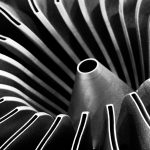
Composite Materials in Modern Aircraft: Beyond the Boeing 787
All modern aircraft – regardless of whether they’re military, cargo, or passenger – are incorporating an increasing number of composite materials into the design and fabrication processes. Perhaps one of the best examples in recent years is the Boeing 787 – a marvel of engineering and a stunning experience for anyone fortunate enough to fly on one. The advancements of the 787 have set the course of the aviation industry to increase the overall range and efficiency of aircraft.
A Look at the Boeing 787
The Boeing 787 was originally designed to replace the legacy 767–a widebody aircraft with a traditional aluminum fuselage and less fuel-efficient turbines than many modern aircraft. Several changes in the 787 design have led to a 20% increase in fuel efficiency over the 767.
First, most of the airframe is made from lightweight composite materials such as carbon fiber-reinforced polymer. Heavier metals like steel, titanium, and aluminum were used sparingly where no other good options were available. The fuselage, for example, is made of several interlocking composite tubes instead of aluminum panels. The benefit of this design can only partially be measured in fuel efficiency.
Using composites helps maintain the cabin at a higher pressure, making the ride more comfortable for passengers. The composite panels also allow the air to be humidified. Since fewer components are made of metal, there is less risk of corrosion with more humid air. Finally, maintenance on the 787 is easier with the composite fuselage and wings since inspections can be visual rather than with electrical currents or ultrasound. As the number of components made with composite materials increases, so do the benefits.
Other Applications of Composites in Aerospace and Defense
Different aircraft have used composite materials since the 1970s; however, the Boeing 787 was the first commercial aircraft to make extensive use of these materials. In fact, over 50% of the aircraft’s weight is composed of lightweight composites. Within commercial civilian aviation, the Airbus A350 is another notable example of extensive use of composite materials.
In military and defense aviation, lightweighting with composite materials has become increasingly important for fuel efficiency, extending range, and superior maneuvering capabilities.
The F-35 Lightning II is widely regarded as the most advanced fighter aircraft in the United States Air Force. Advanced stealth design, improved avionics and sensors, and mission versatility all contribute to the F-35’s current spot at the top of the heap. Many of these achievements are only possible (in part or in whole) because of the incorporation of composite materials. By weight, approximately 35% of the F-35’s airframe is made of composite materials, which allows for an increased range, payload, and maneuvering capability over earlier generations of the same aircraft.
Composites and Other Lightweighting Methods
Composites aren’t the only way to help reduce weight in aircraft. New technologies such as aerogels (used in the 787) are being used to help insulate the cabins of civilian and military aircraft. Other technologies such as hollow turbofan blades and self-healing materials also help to reduce weight.
One little-known way of reducing weight is by using composite materials and plated thermoplastics in connectors and EMI housings. These components used to be made out of metal which added to the weight of the aircraft. With hundreds of thousands of connectors in a single commercial aircraft, reducing the weight of each connector, even if only by a few grams, can have an outsized effect on the fuel efficiency of the aircraft over the course of the aircraft’s life. In addition to reducing the weight of the aircraft, the plated connectors also help with corrosion resistance, temperature resistance, and improved conductivity.
Wrapping Up
As civilian aviation continues to push for greener travel and the military continues towards better performance and superior maneuverability, the demand for lightweighting with composite technologies will continue to grow. SAT Plating is helping to advance lightweighting in the A&D industry with plating performance plastics as well as plating carbon fiber to help with lightning dissipation on composite airframes. Whether you need an R&D partner or production of over a million pieces a year, SAT Plating has the skills and capacity to make your project a success. Get in touch with one of our plating specialists today to receive a quote or to answer any questions you may have!






